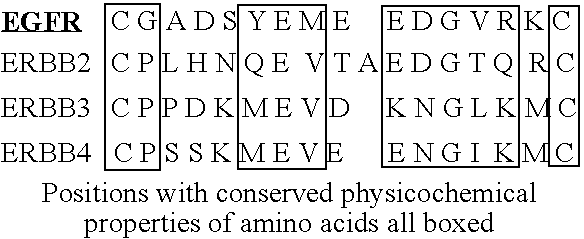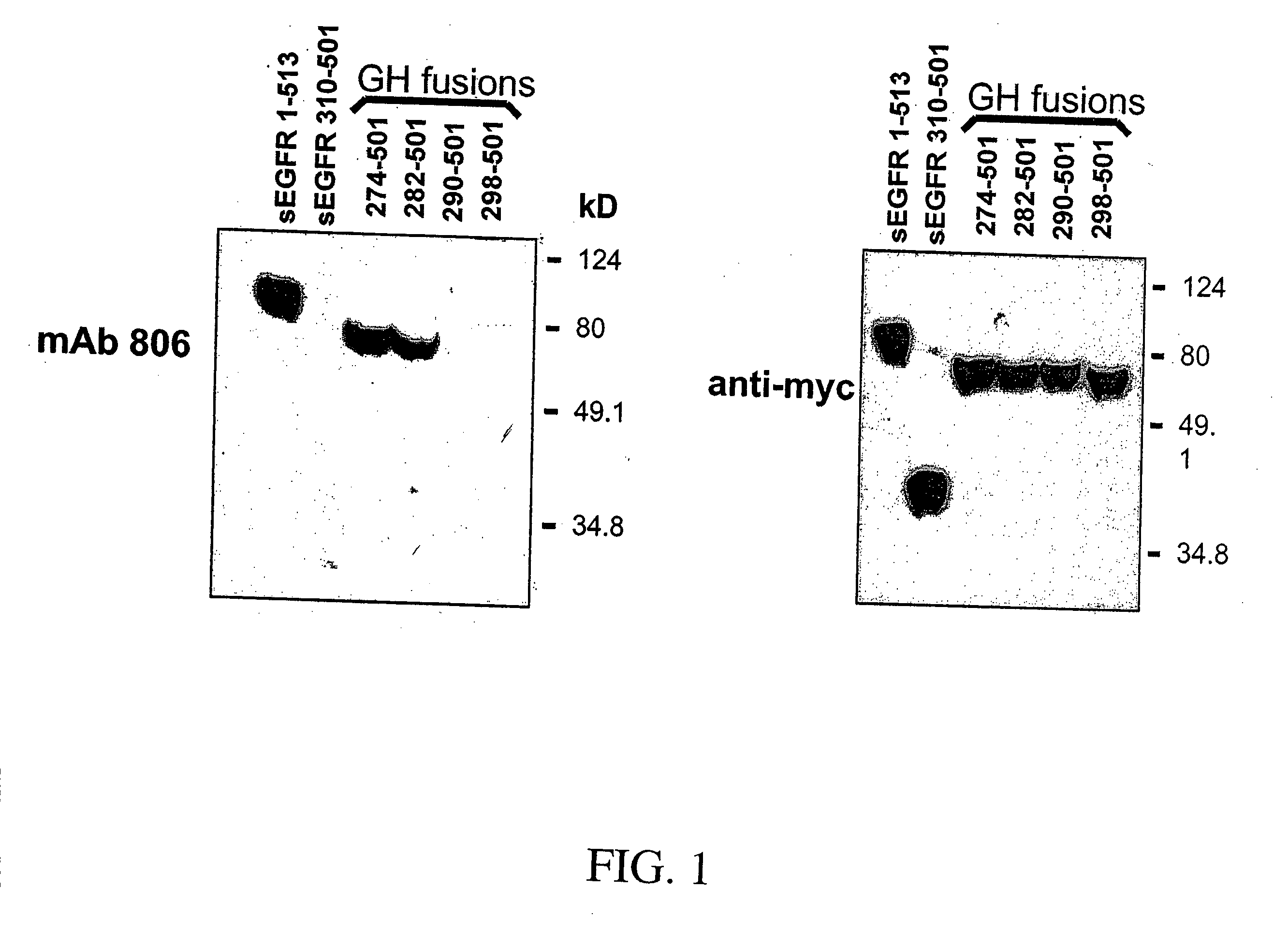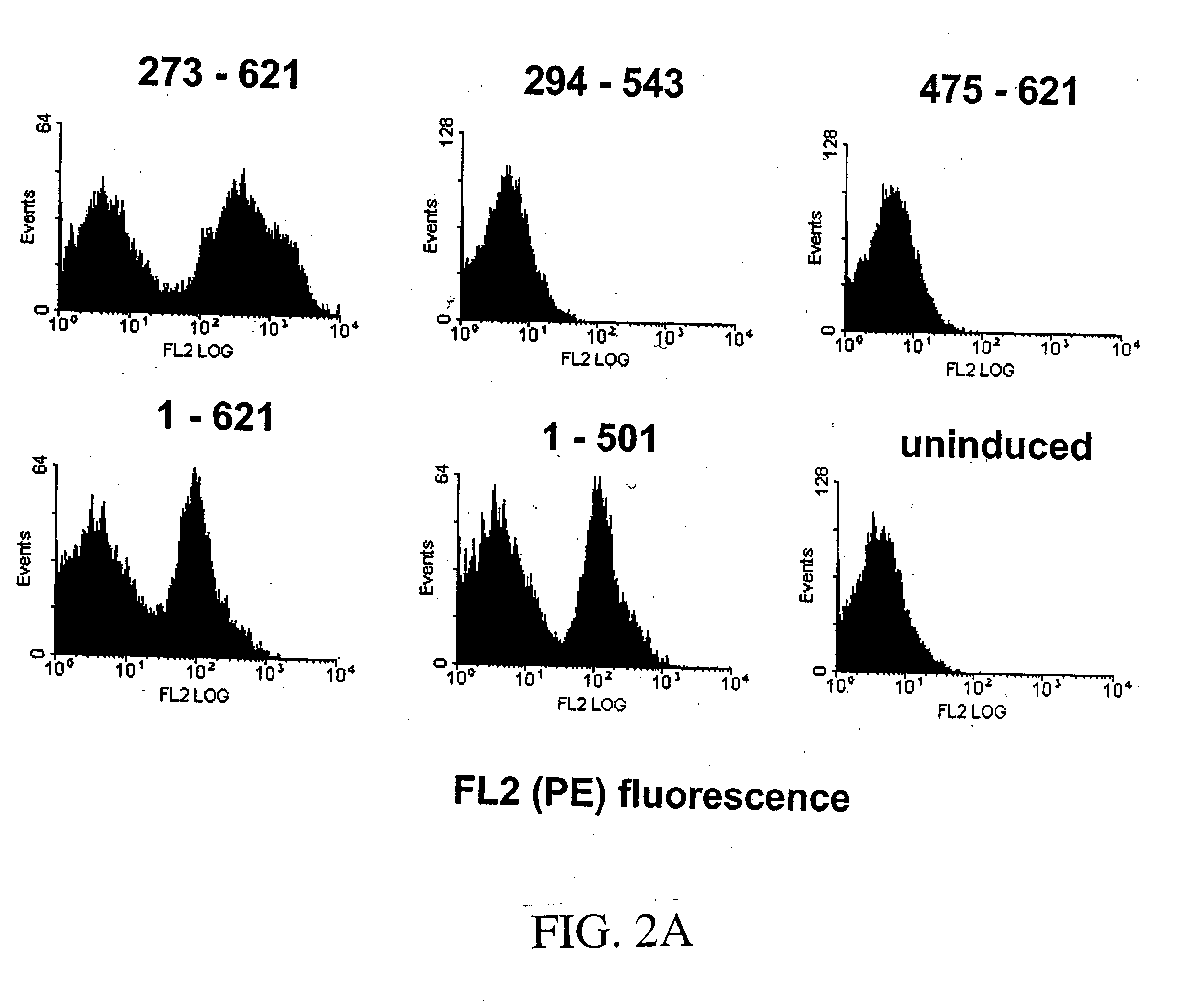EGF receptor epitope peptides and uses thereof
a technology of epitope peptide and growth factor receptor, which is applied in the field of epitope peptides of growth factor receptors, can solve the problems of limiting the use of therapeutic targeting the receptor, toxicity to normal tissue as well as cancer cells, and potential harm to normal tissue,
- Summary
- Abstract
- Description
- Claims
- Application Information
AI Technical Summary
Benefits of technology
Problems solved by technology
Method used
Image
Examples
example 1
[0297] The epidermal growth factor receptor (EGFR) is over-expressed in many epithelial cancers, an observation often correlated with poor clinical outcome. Over-expression of the EGFR is commonly caused by EGFR gene amplification and is sometimes associated with expression of a variant EGFR (de2-7 EGFR or EGFRvIII) bearing an internal deletion in its extracellular domain. MAb 806 is a novel EGFR antibody with significant anti-tumor activity that recognizes both the de2-7 EGFR and a subset of the wild type (wt) EGFR when over-expressed, but does not bind the wt EGFR expressed in normal tissues. Despite only binding to a low proportion of the wt EGFR expressed in A431 tumor cells (˜10%), mAb 806 displays robust anti-tumor activity against A431 xenografts grown in nude mice. To elucidate the mechanism leading to its unique specificity and mode of anti-tumor activity, we have determined the EGFR binding epitope of mAb 806. Analysis of mAb 806 binding to EGFR fragments either expressed ...
example 2
Analysis of CR1 / CR2 Domain Interactions on the Function of the Cell-Surface Epidermal Growth Factor Receptor
[0368] Recent crystallographic data on the isolated extracellular domain of the Epidermal Growth Factor Receptor (EGFR) have suggested a model for its activation by ligand. We have tested this model in the context of the full-length EGFR displayed at the cell surface, by introducing mutations in two regions (CR1 and CR2) of the extracellular domain thought to be critical for regulation of receptor activation. Mutations in the CR1 and CR2 domains have opposing effects on ligand binding affinity, receptor dimerization, tyrosine kinase activation and signaling competence. Tyr246 is a critical residue in the CR1-loop, which is implicated in the positioning and stabilization of the receptor dimer interface after ligand binding: mutations of Tyr246 impair or abolish receptor function. Mutations in CR2, which weaken the interaction that restricts the receptor to the tethered state, ...
example 3
Fine Epitope Mapping of Anti-Epidermal Growth Factor Receptor Antibodies Through Random Mutagenesis and Yeast Surface Display
[0442] Fine epitope mapping of therapeutically relevant monoclonal antibodies (mAbs) to epidermal growth factor receptor (EGFR) was accomplished through random mutagenesis and yeast surface display. A yeast surface-displayed library of single point mutants of an EGFR ectodomain fragment (residues 273-621) was constructed by random mutagenesis, and the library was sorted for reduced binding to a mAb of interest. If an EGFR mutant shows loss of binding to a mAb, this suggests that the mutated residue is potentially a contact residue. Using this method, we have identified key residues energetically important for the binding of mAb 806 to EGFR. The mAb 806 epitope was localized to one face of the loop comprised of residues Cys287-Cys302, which is constrained by a disulfide bond and two salt bridges. The mAb 806 epitope as identified here is not fully accessible i...
PUM
| Property | Measurement | Unit |
|---|---|---|
| Fraction | aaaaa | aaaaa |
| Molar density | aaaaa | aaaaa |
| Molar density | aaaaa | aaaaa |
Abstract
Description
Claims
Application Information
 Login to View More
Login to View More - R&D
- Intellectual Property
- Life Sciences
- Materials
- Tech Scout
- Unparalleled Data Quality
- Higher Quality Content
- 60% Fewer Hallucinations
Browse by: Latest US Patents, China's latest patents, Technical Efficacy Thesaurus, Application Domain, Technology Topic, Popular Technical Reports.
© 2025 PatSnap. All rights reserved.Legal|Privacy policy|Modern Slavery Act Transparency Statement|Sitemap|About US| Contact US: help@patsnap.com



